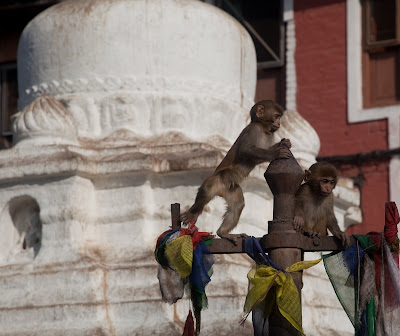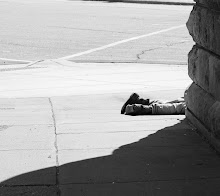 I spent my last day racing around trying to make up for the time I'd lost during the General Strike. Late afternoon I found myself in Patan (sometimes called Lalipur), thought to be the oldest Buddhist city in the world. Some historians date the first temples to 299 AD.
I spent my last day racing around trying to make up for the time I'd lost during the General Strike. Late afternoon I found myself in Patan (sometimes called Lalipur), thought to be the oldest Buddhist city in the world. Some historians date the first temples to 299 AD.The city is known for its architecture, pottery, and Patan Durbar Square, the former residence of the Patan Royal family. When I visited I was the only white face in sight and I got a buzz walking around a city which felt unchanged in 100's of years. Old buildings still house families and businesses and there's very little vandalism from an unrestrained developer's hammer.








 Like everywhere I'd been in Nepal, the city was full of people with expressive faces and little vignettes of life playing out all around me. It amazes me what you can see if you really look.
Like everywhere I'd been in Nepal, the city was full of people with expressive faces and little vignettes of life playing out all around me. It amazes me what you can see if you really look.I think its such a waste to visit new places and just tick boxes in the guidebook.
You miss so much.
There's so much going on.




 The center piece of Durbar Square is the "Royal Bath" where the Queen used to dip her regal toes in the water many a year ago.
The center piece of Durbar Square is the "Royal Bath" where the Queen used to dip her regal toes in the water many a year ago.

 No trip to Kathmandu is complete without a visit to the giant Stupa at Boudhanath.
No trip to Kathmandu is complete without a visit to the giant Stupa at Boudhanath.
 The Stupa is the largest in Nepal and the holiest Tibetan Buddhist temple outside of Tibet. Originally built in the 14th century, its construction is associated with various myths and stories many of which conflict with one another. After the Chinese invasion of Tibet in 1959, the flood of Tibetan refugees into Nepal resulted in the Temple becoming one of the most important centers of Tibetan Buddhism in the world. Today its an important destination for pilgrimage and meditation and along with the Himalayas has become a symbol around which the tourist industry in Nepal revolves. The majority of the people in Nepal are Hindus but Buddhist symbols are dominant associative images for many people when they think of the country.
The Stupa is the largest in Nepal and the holiest Tibetan Buddhist temple outside of Tibet. Originally built in the 14th century, its construction is associated with various myths and stories many of which conflict with one another. After the Chinese invasion of Tibet in 1959, the flood of Tibetan refugees into Nepal resulted in the Temple becoming one of the most important centers of Tibetan Buddhism in the world. Today its an important destination for pilgrimage and meditation and along with the Himalayas has become a symbol around which the tourist industry in Nepal revolves. The majority of the people in Nepal are Hindus but Buddhist symbols are dominant associative images for many people when they think of the country.












 The center piece of Durbar Square is the "Royal Bath" where the Queen used to dip her regal toes in the water many a year ago.
The center piece of Durbar Square is the "Royal Bath" where the Queen used to dip her regal toes in the water many a year ago.
 No trip to Kathmandu is complete without a visit to the giant Stupa at Boudhanath.
No trip to Kathmandu is complete without a visit to the giant Stupa at Boudhanath. The Stupa is the largest in Nepal and the holiest Tibetan Buddhist temple outside of Tibet. Originally built in the 14th century, its construction is associated with various myths and stories many of which conflict with one another. After the Chinese invasion of Tibet in 1959, the flood of Tibetan refugees into Nepal resulted in the Temple becoming one of the most important centers of Tibetan Buddhism in the world. Today its an important destination for pilgrimage and meditation and along with the Himalayas has become a symbol around which the tourist industry in Nepal revolves. The majority of the people in Nepal are Hindus but Buddhist symbols are dominant associative images for many people when they think of the country.
The Stupa is the largest in Nepal and the holiest Tibetan Buddhist temple outside of Tibet. Originally built in the 14th century, its construction is associated with various myths and stories many of which conflict with one another. After the Chinese invasion of Tibet in 1959, the flood of Tibetan refugees into Nepal resulted in the Temple becoming one of the most important centers of Tibetan Buddhism in the world. Today its an important destination for pilgrimage and meditation and along with the Himalayas has become a symbol around which the tourist industry in Nepal revolves. The majority of the people in Nepal are Hindus but Buddhist symbols are dominant associative images for many people when they think of the country.







That's it for Nepal.
My memories of the country are of the Maoist strike and the beautiful architecture. The people, so open and gentle were a joy to meet. For a place swamped with tourists, I was amazed there was so little of the predatory culture of separating the rich foreigner from their wallets so prevalent in other similar places.
I was also surprised that many Nepalese look to India as an aspirational model for the future. When asked why, they cited the lack of corruption and well planned infrastructure.
India an example of efficient public services and clean government???
Though I defer to the feelings of the local people, I'm not sure that they've got that exactly right.


No comments:
Post a Comment